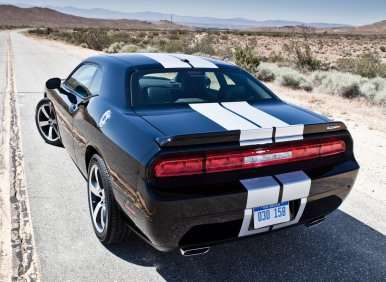Recent Articles
Popular Makes
Body Types
2013 Dodge Challenger SRT8 392 Road Test & Review
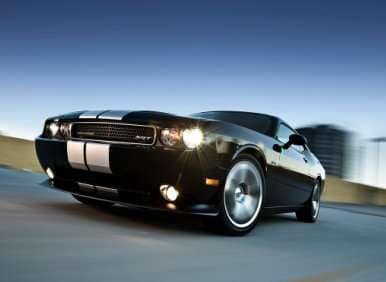
If fast cars are your thing, you are no doubt well aware of the activities of the SRT group within the Chrysler organization. Responsible for such iconic creations as Viper and Prowler, the SRT group is responsible for some of the hottest cars in Chrysler’s recent history.
Starting with the 2012 model year, Chrysler decreed SRT a brand unto itself, complete with a chief executive officer in the person of Canadian Ralph Gilles (pronounced Jeels). To mark the introduction of the brand, Gilles let a raft of all-new white-hot models off the chain to scald the streets. Invigorated with outstanding performance—thanks to a new 6.4-liter HEMI V8 engine, methodically crafted suspension systems, and a suite of purpose-specified comfort, convenience, and infotainment systems—the SRT models promised to elevate Chrysler’s performance cars to a whole new plane.
The first vehicle to benefit from this treatment was the Dodge Challenger SRT8 392. Absolutely brilliant, fast, and good handling, the car was an instant add to performance junkie’s wish lists everywhere. For 2013, the Challenger SRT8 392 has gained more high-tech performance features in an effort to solidify its place among the trio of modern American rear-wheel-drive muscle coupes.
(In other words, to keep pace with Camaro and Mustang.)
2013 Dodge Challenger SRT8 392 Road Test & Review: Models & Prices
Introduced in the Fall of 2012, as the first of the new SRT models to benefit from the capabilities of the new HEMI, the Challenger SRT8 392 can be best characterized as a gentleman’s sport coupe. Larger and heavier than its competitors from Chevrolet (Camaro) and Ford (Mustang), the Challenger 392 also offers a greater degree of comfort and spaciousness. Pricing starts at $43,775
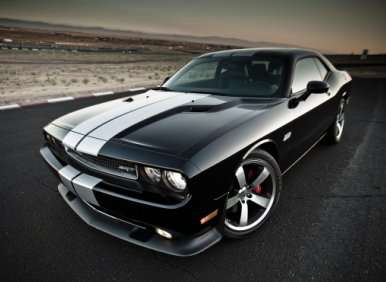
2013 Dodge Challenger SRT8 392 Road Test & Review: Design
Even before you ignite the engine, one look at the 392 tells you what’s waiting for you when you do. All the pieces of kit you see are functional — nothing is added for show. The large front splitter, chin spoiler, integrated front fender spats, and the rear decklid spoiler use the airflow over the car to provide stability and balance at high speeds. With this much power in hand, one does well to invoke the assistance fluid dynamics.
And, while they don’t make the car go any faster, the dual, full-body stripes (available in black, grey metallic, red and silver metallic) do telegraph the SRT8 392’s performance potential. Also, so poseurs know what they are sitting beside at the signal before they do something stupid, like challenge you to an impromptu drag race, “392 HEMI” badges flank both fenders touting the high protein V8 engine’s high-performance potential. In other words, the badges let them know they’re sitting beside the highest rated Challenger in terms of horsepower and torque ratings.
Should they be too dumb to heed the warnings (rendered in red – no less), the last thing they’ll see (and hear) of you — once the tire smoke clears — are the four-inch rectangular exhaust tips delivering the 392’s bone chilling exhaust note; as the handsomely chiseled muscle car recedes into the distance.
On the practical side though, the low-slung cockpit has a negative impact on outward visibility. The rear ¾ view is rather limited.
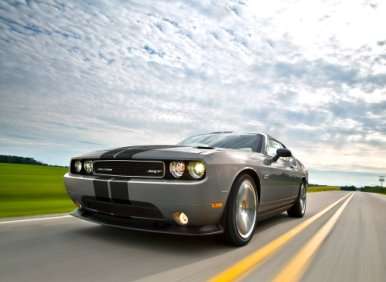
2013 Dodge Challenger SRT8 392 Road Test & Review: Comfort & Cargo
Power lumbar-equipped front seats are standard. The driver’s seat features seatback tilt with memory and an easy to reach release handle. The front-passenger seat adds tilt and slide with memory to make it easier for passengers to get in and out of the back seat. The deeply sculpted sport seats are also cut specifically to hold you in place while the 392 goes about demonstrating its acrobatic prowess.
On the cargo side of things, the Challenger offers 16.2 cubic feet of trunk space, which is more than Camaro and Mustang, but the opening is relatively high, so you have to give bags a pretty significant heft to get them into the trunk. Further, the rear seatbacks fold almost flat, so you can also carry items inside the passenger compartment, expanding the cargo capability of the car even more.
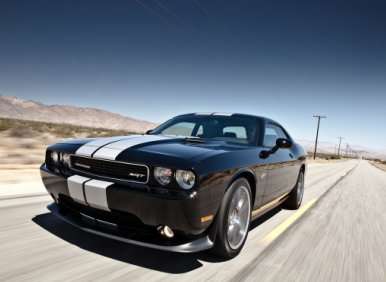
2013 Dodge Challenger SRT8 392 Road Test & Review: Features & Controls
The interior of the 392 SRT8 is designed specifically to help you stay in control. The leather wrapped, heated, SRT-exclusive steering wheel features a satin chrome rim section with a flattened bottom surface so you can tell at an instant how much steering you have dialed in. If you opt for the automatic transmission, you’ll get paddle shifters on both sides of the contoured palm rests sculpted into the wheel.
The SRT Electronic Vehicle Information Center’s (EVIC) performance pages in the instrument panel provide instant feedback on 0-60 times; acceleration, braking and cornering G-forces; one-eighth mile and quarter-mile times.
To help keep your hands where they belong in a car with this much performance potential, audio and EVIC controls are accessible from the steering wheel. Chrysler is one of the few manufacturers to take advantage of the real estate on both the front and the back of the steering wheel. Switches for raising and lowering the volume of the audio system as well as switching through its different source modes are located on the back of the steering wheel’s horizontal spokes.
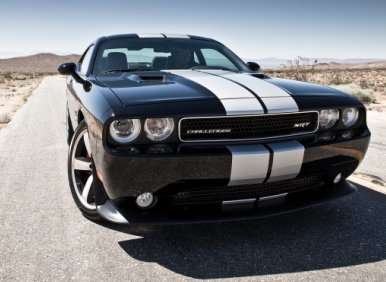
2013 Dodge Challenger SRT8 392 Road Test & Review: Safety & Ratings
The 2013 Dodge Challenger SRT8 392 features standard Keyless Enter-N-Go and a three-mode electronic stability control with Ready Alert Braking and Rain Brake Support. Challenger also offers standard front-row reactive head restraints, standard full-length side-curtain air bags, a driver’s knee bag and standard front seat-mounted side-thorax air bags.
Ready Alert Braking activates when you quickly release the accelerator pedal in anticipation of an emergency braking situation. The electronic stability control pump automatically sets the brake pads lightly against the rotors to decrease the time required for full brake application. Rain Brake Support sets the pads lightly against the rotors at controlled intervals in wet weather to keep the rotors as dry as possible in anticipation of an emergency braking situation.
NHTSA awarded the Challenger five stars overall in its crash test ratings. The car scored five stars in both front and side crashes, four stars in rollovers.
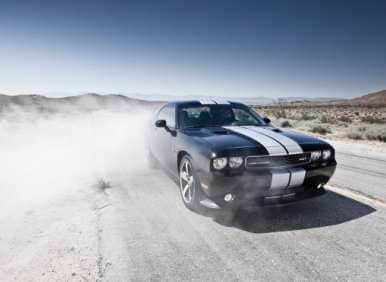
2013 Dodge Challenger SRT8 392 Road Test & Review: Engine & Fuel Economy
According to Chrysler’s historians, the original 392 HEMI engine was introduced with the 1957 model year Chrysler and the company’s flagship Imperial products. It replaced the 354 cubic-inch version of the original HEMI launched in 1951.Compared with the 354 engine, the 392 was completely revised and improved, with larger valves and ports, a beefier block and crankshaft and improved bearings. In short, the 392 HEMI, often affectionately referred to simply as the “92,” was perfect for drag racing
For 2013, Challenger’s 6.4 HEMI dispenses 470 horsepower and 470 ft.-lbs. of torque, while also flaunting the potential for 23 mpg on the highway (when driven conservatively). In our testing, the 392 hit sixty in just under four seconds, ran the quarter in just over 12 seconds, and we saw a top speed of 167 (in our automatic transmission equipped 392) before we ran out of room. And yes, the Challenger was still pulling strong, giving us every reason to trust Chrysler’s top speed claim of 182 with the standard six-speed manual and 175 with the optional five-speed automatic.
Chrysler’s Fuel Saver Technology allows the engine to operate on four cylinders in steady state cruising on the Interstate, or use the power of all eight cylinders when needed—say to blow the doors off an errant interloper. With all of its performance potential, the 392 is rated by the EPA at 14-mpg in the city and a surprising 23-mpg on the highway, regardless of whether you opt for the manual or the automatic transmission.
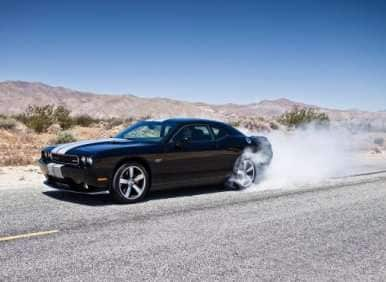
2013 Dodge Challenger SRT8 392 Road Test & Review: Driving Impressions
The 392 squats a half-inch lower on its suspension than standard Challengers, plus it has Chrysler’s adaptive damping suspension system, which was improved for the 2013 model year. Enabling you to dial in the amount of firmness desired for the degree of mayhem you anticipate, the suspension system does a remarkable job of managing the rather large body the Challenger brings to the party. Engaging the 392’s sport button keeps the suspension firmed up to its most aggressive setting, while also holding the automatic transmission in each gear longer to extract the maximum amount of performance from the HEMI.
All of this enables the big Dodge to perform feats of acceleration and road holding fully capable of leaving you slack-jawed. The big Brembo brake system with its vented rotors and four-piston calipers haul the 392 down from speed both hard and repeatedly with no evidence of fade whatsoever.
In short, this SRT8 392 goes fast, stops hard, and corners sharply.
Yes, it is somewhat compromised by having to share its platform with the Charger and 300 sedans, however the level of sophistication it inherits from that situation is also an inarguable attribute. While it is undeniably a large car, the 2013 Challenger SRT8 392 is also one of the most capable performance cars offered for the 2013 model year.
Another improvement for the 2013 model year is the addition of launch control as a standard feature. With the vehicle at a complete stop, pressing the Electronic Stability Control (ESC) button twice, engaging the clutch, and quickly applying full throttle, activates the system. The launch control system then holds the engine at the pre-set rpm and waits for the clutch to be released.
The pre-set launch rpm…
You can pre-set the launch rpm using the Electronic Vehicle Information Center (EVIC) I spoke about earlier. Within it you can choose from a range of between 2500 and 4500 rpm in 250-rpm increments.
Once everything is set, release the clutch and the launch control function accesses the engine torque management system to execute a fast launch with minimal wheel spin and maximum acceleration up to 62 mph.
The procedure is a bit different with the automatic transmission.
Instead of holding the clutch (because there’s isn’t one — duh!) you hold the brake and apply full throttle. The launch control system holds the engine at 1,825 rpm while it waits for you to release the brake. When you do — just as with the manual transmission — the launch control function then uses engine torque management to achieve controlled wheelslip for maximum acceleration up to 62 mph.
All of the excitement isn’t dialed out though, you still get to burn a bit of rubber before the tires hook up, the accelerative forces slam your head back, and the 392 screams away down the strip straight and true.
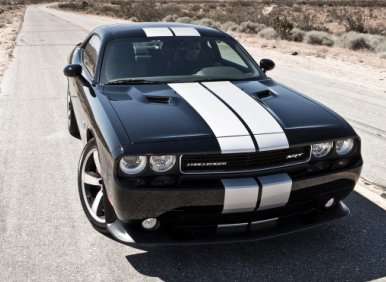
2013 Dodge Challenger SRT8 392 Road Test & Review: Final Thoughts
Overall, when compared to its chief rivals, the extremely high-powered iterations of Chevrolet Camaro and the Ford Mustang, the Challenger 392 is a merely contender, not a winner. Yes, it pushes all the right buttons in the sound and fury department. But it feels positively huge compared to those cars which themselves feel big when compared to their imported rivals. Plus they both offer considerably more horsepower for the money.
Still, if you’re looking for the quintessentially American muscle car feel, the Challenger 392 gets closer to that than the Camaro’s arguably relatively more sophisticated ways. And, while the Mustang has the benefit of that smooth high winding V8 on its side, the Challenger, on the move, feels a bit more polished and refined than the Mustang — in my opinion.
Interior-wise though, the Challenger 392 is in sore need of an update. There is still way too much bland plastic in the car, and way too many broad, featureless surfaces. The Challenger shares its platform and underpinnings with the larger Chrysler 300 and Dodge Charger. Both of those cars got very nice makeovers recently, it’s time for the Challenger to get one too.
Thing is, with a model as iconic as the Challenger, and given the historic iteration of the car only had a single body style (unlike Camaro and Mustang), it will be interesting to see what Chrysler does as a follow-up, or if the Challenger will just fade away like the PT Cruiser did. For my part, I’d love to see a more contemporary execution of the concept, in a smaller, tidier package— with all the performance potential left intact.
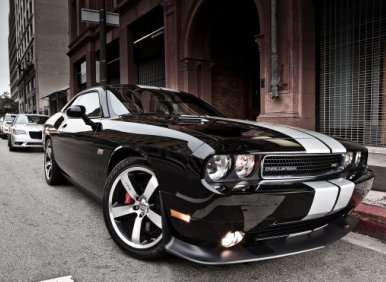
2013 Dodge Challenger SRT8 392 Road Test & Review: Pros & Cons
• Brilliant engine and aggressive handling
• Nostalgia factor’s handsome appearance
• Comfortable and supportive seats
• Spacious trunk
Outperformed by comparable Camaro and Mustang models
• Bland styling of interior could stand a redesign
Feels a bit big going down the road
Rear ¾ outward visibility compromised
